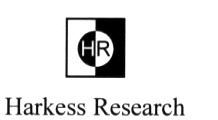
 Wisp
Unification Theory
Wisp
Unification Theory
 Questions
and Answers
Questions
and Answers
- Home
- About Me
- Reasons why Einstein was wrong
- One-way speed of light experiments
- Hot topic
- Q & A
- ACES - The end of Relativity
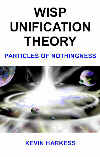
- Book Contents
- Introduction
- 1 Matter,Space and Time
- 2 Symmetry
- 3 Fractals
- 4 Wisp Space
- 5 Gravity
- 6 Electromagnetic Force
- 7 Wisp & S.R: Fundamentals
- 8 Wisp & S.R: Electrodynamics
- 9 Wisp & S.R: Doppler effect
- 10 Wisp & S.R: Relativistic Mechanics
- 11 Big bang
- Appendix A
- Appendix B
- Index A-Z
- Copyright
- Feedback
Questions and Answers
A theory that is close to the theory of everything should be able to provide answers to the deeper questions of physics in a clear and simple way, and support new findings. Wisp theory does this remarkable well.
Is there a God?
This is a personal choice. I believe that there is a presence that is able to influence our lives.
Our universe is a small part of a larger infinite system, and the chance of higher intelligence having eternal existence is real. Once you understand the nature of time you will know that it is possible for this intelligence to know all our thoughts. However, we do not need a God to exist, but the presence of a higher intelligence is beneficial to us given the way we behave.
Why do we exist?
I have the answer and will update this site soon when wisp theory is given some recognition. However, as wisp theory has been ignored by mainstream science for over 20 years I am in no rush to provide the answer. But I will give you some of my thoughts that follow on from wisp theory. You must first accept the fact that space is in no way affected by time, and the presence of matter in space does not cause it to bend space (Nikola Tesla knew this). You need to understand time in order to work out why we are here.
Here are some new ideas that I will write about soon:
The universe is infinite. It has no beginning, middle, or end. It has always existed and always will. The infinite system self creates universes. We are just one of many universes.
A universe is made up of 2 states of space. Zero-state space (void) and one-state space (wisp ether). Certain conditions need to be met to form a universe from these states of space.
You are unique. The fact that you even exist is unbelievably unique. You are a one off. However, the way we feel and think is the same, feeling happy, anxious or depressed is the same for all human beings. We just occupy different bodies. For some their quality of life is poor and they struggle to survive, but grow stronger as a result.
Our visible universe is just a small part of an infinite system. There are many universes out there, all at different stages of development, some are dormant because they did not have enough ether or energy to form an ultra-supermassive black hole needed to create a big bang event. Some parts of space are void of ether. Some have ether only and no energy. It's basically a mixed bag and our chance of being here is random.
When a universe collapses and is absorbed by its ultra-supermassive black hole the second law of thermodynamics is violated. The total entropy of that universe is reset to its lowest value. With an infinite system if the entropy did not reset we would cease to exist. Black holes reset entropy as they contain zero-state space (void) at their centres.
The answer to the question "Why do we exist?" will be coming soon. Maybe?
What is ether (aether)?
It is a substance that is made from tiny particles called wisps. I call empty space "zero-state space", and full space "one-state space". We think of space as being void, but in reality it is full of weightless one-state particles (wisps). The ether is responsible for the propagation of light and force. No friction force exists between wisps, but they are bound together by a strong force - wisp force, which is similar in strength to the nuclear force. It is the fifth force in nature, from which the other four forces are derived.
In free space, wisps are in closer together and the binding force is at its least. Close to large material bodies, wisp space density reduces but wisps are forced apart by curvature, and the binding force is greater. Close to bodies the circular curvature causes the binding force to follow the inverse square law.
The ether density in "empty space" is far greater than
any substance known to man.
Sir Oliver Lodge predicted its properties in his 1933 Lecture - The Mode
of Future Existence.
That Ether is a very substantial entity, far denser than any form of matter, has been gradually becoming clear to physicists. At first, we only said that it must be denser than lead or gold or platinum, but now we find that it must be out of all proportion denser. I have made an estimate of its density, in the light of electromagnetic theory, and it comes out inevitably huge. Every cubic millimetre contains as much substance as what, if it were matter, we should call a thousand tons. As the Ether is not matter in the ordinary sense of the term, our ordinary units of measurement are inappropriate; but on the analogy of matter, the Ether is of the order a million million times as dense as water. All its properties are of supernormal magnitude. Its rate of vibration which enables us to see any ordinary object is five hundred million million per second: a number so great that to try to conceive such a number of vibrations per second simply dizzies us. The number of seconds which have passed since ancient geological periods of twenty million years ago is about this number. Yet we familiarly make use of these vibrations. Our wonderful organ, the eye, is constructed so as to cope with them, in the easiest possible manner. And most people are ignorant - as ignorant as are the animals - of the strange ethereal environment amid which we all live, and of which the vibrations convey to us so much information, and awaken so keenly our sense of beauty.
What is matter?
It is a spherical distortion in the ether (wisp space) that forms because of the presence of a hole (empty zero-state space). The ether cannot fill the hole, but it does wrap around it forming spherical symmetry. I call these patterns matter-fractals (fig 4.2) and they form the fundamental particles of physics.
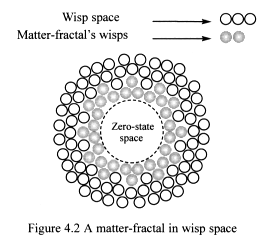
What we normally perceive as empty space is in fact a rock solid lump of wisps densely packed with enormous mass. Fundamental particles exist as regions of reduced density in the ether (fig 4.2b). Our perception of what fundamental particles are (fig 4.2a) is based on a "photographic negative" of reality.

Fig 4.2a We think matter is something solid in an empty space "a photographic negative of reality"
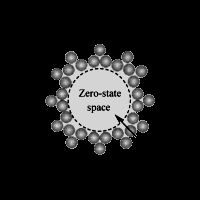
Fig 4.2b Matter is something empty in a solid ether space
How does matter get its mass from the ether?
The tiny particles (wisps) that make up the ether have mass and there are a finite number of them associated with each type of fundamental particle, which form patterns (matter-fractals) around holes in the ether, and each pattern has a unique mass value. And this is its absolute inertial mass.
Isn't the wisp really just another name for the higgs particle?
They are similar in that they both claim to be responsible for giving matter its mass. But higgs bosons are associated with a field and wisps exist as discrete sized particles and so are fundamentally different. I believe the higgs to be a standard boson that can be created within the wisp ether, and so does not play a role in providing matter with mass. The higgs field can be likened to the ether, which does provide matter with its mass. Particles get their mass from the ether, the higgs boson gets its mass from the ether, the higgs boson does not give particles mass.
What is gravity?
The presence of matter in the ether causes displacement of ether, which results in a reactive force from the ether putting a squeeze back on matter. It's like stretching an elastic band into a circle. It develops circular tension force, which in turn produces an inward acting radial compression force. Imaging you are entering a crowded room and there is no room for you. You force your way in and you feel you are getting squashed by the people around you. Similarly, this is what creates the circular tension in the ether, and ultimately creates the gravitational force.
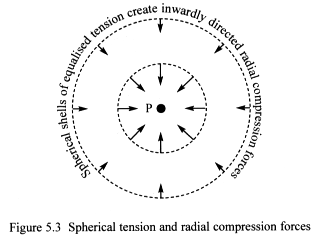
The key to understanding how gravity works is in understanding how the radial compression force acts on the upper surface of the zero-state sphere (empty hole) at the centre of the matter-fractal. This ensures that gravity obeys an inverse square law and not an inverse cube law that would otherwise result. The radial compression force acting down on the upper surface of the matter-fractal's zero-state sphere causes the gravitational effect. The lower surface does not have a reactive force directed up as the radial compression forces are vectored downwards.
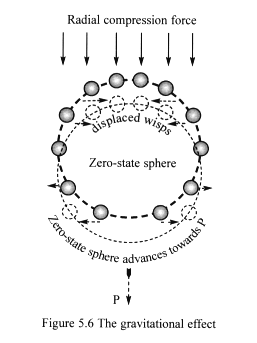
Newton thought that the cause of gravity migh be due to this ether pressure (Opticks query 21) but a difference in pressure across the particle would result in a inverse cube law. All that is needed to solve the mystery is the empty hole "zero-state sphere". See chapter 5 for a full discusion on gravity.
Does dark matter exist?
No. Dark matter is not a physical thing, i.e., it's not a form of exotic matter, it's a gravitational effect caused by rotating ether (wisp space), which stretches ether bonds, magnifying the gravitational effect. Wisp space rotates about spinning black holes at the centres of galaxies. And any mass that rotates causes the surrounding wisp space to rotate (it’s a requirement of the physical law – conservation of angular momentum – that the surrounding ether rotates, because matter is holes in the ether). Rotation magnifies the variation in density of across particles (matter-fractals) in wisp space. This density variation is present in non-rotating space and may be partly responsible for the pioneers' orbital discrepancies, see figure 5.11. Additional ether rotation caused by the Sun’s spin will amplify the effect.
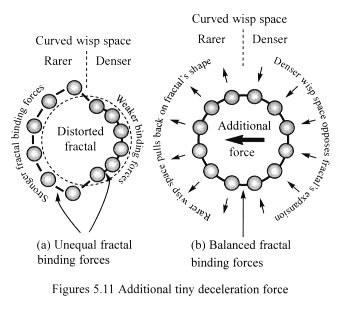
This effect has recently been detected around the spinning
Earth. It is likely the extra gravitational pull is a combination of ether
density variation distorting the satellites’ matter-fractals and ether
rotation due to the Earth’s spin amplifying the effect, see
http://space.newscientist.com/article/dn13411-earths-rotation-may-account-for-wayward-spacecraft.html
Rotating space amplifies this tiny force producing the dark matter gravitational effect.
Dark matter doesn't exist as a physical substance, it's cause caused
by the ether. See Glenn Starkman's article
http://news.nationalgeographic.com/news/2006/09/060908-dark-matter.html
Wisp theory supports the idea that non-rotating elliptical galaxies do not possess dark matter, see http://physicsweb.org/article/news/7/9/1
The suggestion that dark matter is a gravitational effect
caused by an invisible fluid "ether" is given further support by theoretical
physicist Robert J. Scherrer, see
http://exploration.vanderbilt.edu/news/news_k_essence.htm
For an update on pioneers' orbital discrepancies, see
http://education.guardian.co.uk/higher/sciences/story/0,12243,1302857,00.html
What causes space to expand?
If you make a hole in the ether (wisp space), a spherical fractal pattern (matter-fractal) forms around the hole, which causes the surrounding ether to expand slightly as the density of ether around the fractal is reduced. So we can conclude that the expansion in ether is proportional to the total surface area of its matter-fractals' "zero-state spheres". This was minimum before the big bang event, as there was just one large zero-state sphere at the centre of an ultra-suppermassive black hole. After the big bang, the single zero-state sphere broke into many smaller ones, some formed galaxy seed fragments and others the fundamental particles. The total surface area of the smaller zero-state spheres is much greater and this resulted in a massive positive expansion pressure in the ether.
Contraction and the slow crunch
The reverse effect of expansion occurs when black holes swallow matter-fractals, the ether contracts. As the universe ages the contraction of space will overtake its expansion, resulting in a "big crunch", although the collapse of the universe will be an extremely slow process and perhaps should be renamed the "slow crunch".
What causes the spiral structure in galaxies?
If there is a small residual rotation in a galaxy then this can be magnified. When the black hole at the centre of the galaxy absorbs matter, the surrounding ether (wisp space) contracts reducing its density. The law of conservation of angular momentum must be upheld and so the ether in the galaxy rotates faster. This starts with the ether near the centre and works outwards, creating density waves, which form the spiral arm structures.
How did supermassive black holes form?
Astronomers have collected evidence that suggest all galaxies
have supermassive black holes at their centres. Their masses are about
0.5 per cent (typically several million to a billion solar masses) of
that of their host galaxies.
How they came to exist is a mystery, but wisp theory suggests that they
are fragments of zero-state space blasted out during the big bang.
This is supported by recent findings that show supermassive black holes
existed near the start of the big bang. See
http://news.bbc.co.uk/1/hi/sci/tech/7815827.stm
http://www.newscientist.com/article/dn16377-black-holes-grew-up-before-galaxies.html
http://www.nrao.edu/pr/2004/quasarbh/
Stunning Three Dimensional Model of the Universe - The Millennium
Run, see
http://www.youtube.com/watch?v=bU-WRQdiWOI&fmt=37
First ever picture of a black hole
Here is a link to an image produced by Katie Bouman. The
image shows a supermassive black hole at the centre of M87 produced by
an algorithm designed by Katie of data collected form telescopes around
the world. See
http://www.bbc.co.uk/news/science-environment-47891902
Home --
About Me -- Reasons
why Einstein was wrong -- One-way
speed of light experiments -- Hot
topic -- Q&A --
ACES - The end of Relativity --
Book Contents -- Introduction
-- 1 Matter,
Space and Time -- 2
Symmetry -- 3
Fractals -- 4 Wisp Space
-- 5 Gravity -- 6
Electromagnetic Force --
7 Wisp & S.R: Fundamentals
-- 8 Wisp & S.R: Electrodynamics
-- 9 Wisp
& S.R: Doppler effect -- 10
Wisp & S.R: Relativistic Mechanics --
11 Big bang -- Appendix
A -- Appendix B -- Index
A-Z -- Copyright -- Feedback